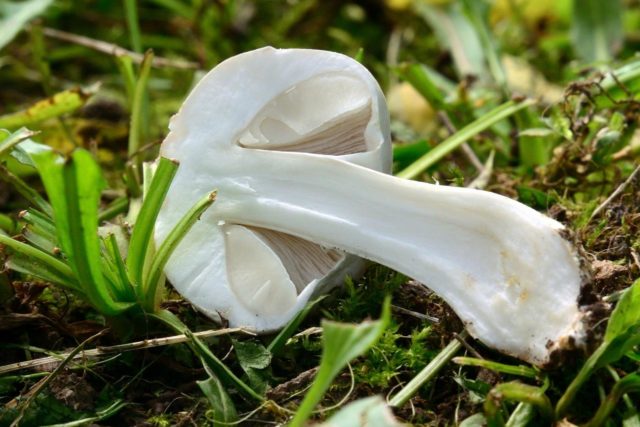Content
The red-plated white champignon (Leucoagaricus leucothites) has a second name - Ruddy Umbrella. They call it that because when it dries, the cap becomes “ruddy.” Belongs to the Champignon family, genus Belochampignon. In Hebrew it is called Beloshampignon nut, or Lepiota nut because of its slightly nutty aroma. Outwardly, it is similar to white-colored champignon and other poisonous gifts of the forest, but there are still distinctive features.You can learn further about where to look, how to distinguish them from doubles, and whether they are worth eating.
What do red-plated white champignons look like?
In young specimens, the cap is hemispherical in shape and white; with age it becomes more open and acquires a soft pink hue. Its size varies from 4 to 8 cm. The red plate champignon has a thin and smooth white leg. Its length is from 6 to 10 cm, and its thickness is from 5 to 8 mm. You can distinguish a young specimen from an old one by the presence of a ring on the leg, which disappears as it matures. Spores are ellipsoid, smooth, colorless, 8-10 × 5-6 µm.
Where do red-plated lepiots grow?
The optimal time for the growth of this type of mushroom is from July to October. The ruddy umbrella is quite often found in gardens, parks, fields, lawns and pastures. Thus, the main habitat is grass. They can grow either singly or in groups consisting of 2–3 fruiting bodies.
Is it possible to eat umbrellas that are blushing?
Although some question the edibility of the red plate champignon, most sources classify it as edible, and experienced mushroom pickers are happy to collect and use them for food.
Taste qualities of the white champignon mushroom
Those who have tried red plate white champignon note a pleasant taste and a light, unusual fruity aroma. Many gourmets claim that its smell is reminiscent of chicken meat and has a pronounced mushroom taste.
Benefits and harm to the body
As you know, any edible mushroom is beneficial for the body, since it contains the necessary proteins, fats, carbohydrates, vitamins and microelements.Due to its low calorie content, red plate champignon allows you to lose weight, and its low glycemic index cleanses the body of toxins and saturates it with useful substances.
False doubles
The blushing umbrella is quite often mistaken for a white-colored champignon, but there is nothing to worry about, since both options are edible. However, this specimen can be confused with false doubles, which can cause irreparable harm to health. These include:
- Lead-slag green plate - grows in the same area as the white champignon. It is considered a poisonous mushroom. A distinctive feature is that the red-plated white champignon has pinkish-colored plates, while its counterpart has pale green plates, and with age they acquire a greenish-olive tint.
- Amanita stinking (white toadstool) – is considered a deadly poisonous mushroom. When young it has a hemispherical cap, and with age it becomes more convex. The pulp is white, with an unpleasant odor reminiscent of chlorine. Quite often, filmy flakes form on the cap. The species in question can be distinguished from its double by the absence of a Volvo. In the fly agaric it is cup-shaped or bag-shaped, often immersed in the soil.
Collection rules
Red-plated white champignons should not be collected near landfills, enterprises, roads and highways, as they absorb all toxic substances well and thereby can harm the body.
Due to its fairly common shape, this specimen can be confused with any other.Therefore, in order to avoid poisoning, experts recommend not collecting those gifts of the forest that the mushroom picker doubts.
Use
Many people eat red-plated white button mushrooms, but it is extremely important not to confuse them with their false counterparts. Many reference books indicate that these mushrooms can be eaten raw, fried and pickled. However, there are no generally accepted cooking recipes.
Conclusion
Red plate champignon is a useful product that can be found almost anywhere. However, its pale appearance, reminiscent of a toadstool, can be alarming, and the likelihood of confusing it with a poisonous specimen is quite high. Therefore, if a mushroom picker is not sure that it is a blushing umbrella in his hands, then in this case it is better to throw away this specimen.












